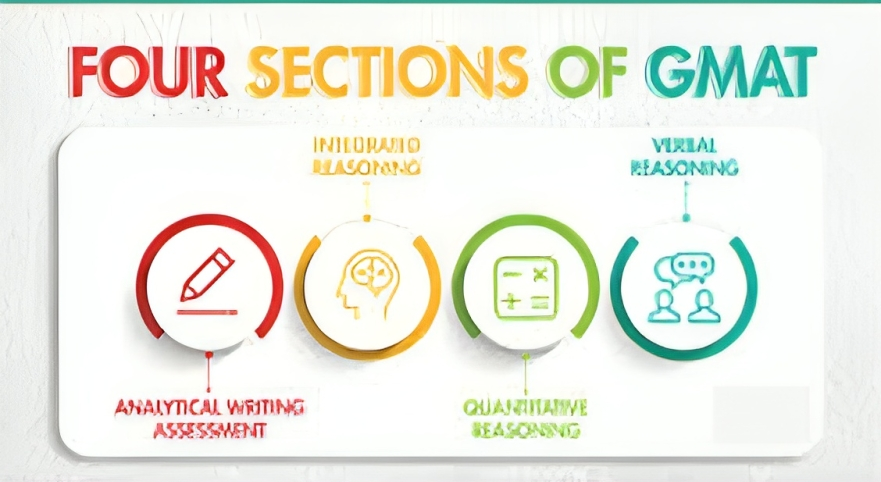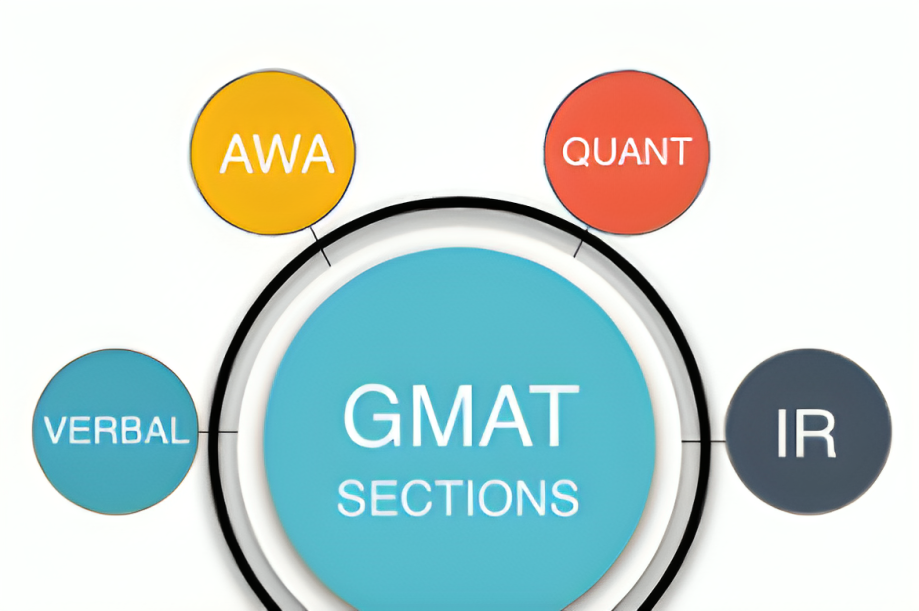One of the most important exams for candidates seeking admission to some of the most prestigious business schools in the world, the GMAT consists of both subjective and objective questions and is a computer-adaptive test with a total of 80 questions that must be answered in 3 hours and 7 minutes.

GMAT Exam Pattern: Key Highlights
- The GMAT is a computer-adaptive test for Verbal Reasoning and Integrated Reasoning.
- The GMAT exam has no defined syllabus. It consists of questions focused on testing analytical and reasoning skills.
- The GMAT consists of 80 questions and has a time frame of 3 hours and 7 minutes. The exam has no defined syllabus and consists of questions focused on testing analytical and reasoning skills.
- Candidates are given the option of choosing amongst three combinations of the order in which they can attempt the GMAT Exam.
- Each section of the GMAT exam has a time limit, which varies according to the sections.
- The sections for Integrated Reasoning and Verbal Reasoning are computer-adaptive, i.e., the questions cannot be skipped, the page cannot be returned, and the answers once marked cannot be changed.
- Quantitative Reasoning and Verbal Reasoning sections consist of multiple-choice questions.
- Analytical Writing Assessment consists of an essay question.
- Integrated Reasoning consists of non-MCQs, i.e., TITA (Type in the Answer) type of questions.
- There is no negative marking in the
- Exam.
- There are eight-minute optional breaks given between the exams, the timing of which must be selected by the candidate by choosing the order.
The table below gives some more details about the GMAT Exam and the GMAT Exam Pattern:
| Exam Name | Graduate Management Admission Test (GMAT) |
|---|---|
| Official GMAT Website | www.mba.com |
| Exam Organizer | Graduate Management Admission Council |
| Section Division | 4 |
| Total Number of Questions | 80 |
| Score Range | 200-800 |
| Average score range | 556 |
| Language Medium | English |
| Mode of Examination | Computer-Based |
| Negative Marking | None |
| Exam Duration | 3 hours 7 minutes |
GMAT Exam Pattern (Section-wise)
| Section | Time Limit / Number of Questions | Question Types | Score Range |
|---|---|---|---|
| Analytical Writing Assessment | 30 minutes / 1 question | Analysis of an Argument (50%), Issue Essay (50%) | 0-6 (in 0.5-point increments) |
| Integrated Reasoning | 30 minutes / 12 questions | Graphics Interpretation, Table Analysis, Multi-source Reasoning, Two-part Analysis | 1-8 (in 1-point increments) |
| Quantitative Reasoning | 62 minutes / 31 questions | Data Sufficiency (50%), Problem Solving (50%) | 6-51 (in 1-point increments) |
| Verbal Reasoning | 65 minutes / 36 questions | Reading Comprehension (60%), Critical Reasoning (20%), Sentence Correction (20%) | 6-51 (in 1-point increme |

Verbal Reasoning:
The candidate’s grasp of the English language is examined in this phase. There will be 36 questions in this section, and you have 65 minutes to complete them. In the Verbal Reasoning part, there are
- Reading Comprehension: The candidate’s logical and reading skills are tested in this portion. It also examines the candidate’s writing style.
- Sentence Correction: Sentence correction assesses the student’s sound grammatical abilities and language organization.
- Critical Reasoning: Critical reasoning examines a candidate’s capacity for making decisions.
How is the Verbal Reasoning Score calculated?
Scores for verbal reasoning are determined using a set scale that runs from 0 to 60. Although the score systems for verbal and mathematical reasoning are similar, they are based on fundamentally separate conceptions.
The GMAT at-home exam format is almost identical to the GMAT test-based exam format. The test assesses your verbal, quantitative, and analytical thinking abilities, all of which are necessary for post-graduate business study.
| Section | No. of Questions | Time Duration |
|---|---|---|
| Quantitative Reasoning | 31 | 62 mins |
| Verbal Reasoning | 36 | 65 mins |
| Integrated Reasoning | 12 | 30 mins |
| Analytical Writing Assessment | 1 | 30 mins |
Analytical Writing Assessment (AWA):
One question, consisting of a brief text with an argument, makes up the entirety of the AWA section. The candidate is supposed to evaluate the argument and point out any flaws in an essay format. This portion assesses the candidate’s capacity for critical thought as well as their written communication skills.
How is AWA Score Calculated
The elements of the section that were evaluated by these evaluators are listed below. This section’s score is computed using two independent scores from two evaluators.
- The electronic system evaluates sentence structure, core approach, and writing flow.
- The examiner manually evaluates the writing style, concept flow, analysis of the arguments, and provided examples to support the use of logical reasoning.
Integrated Reasoning (IR):
The integrated thinking portion evaluates a candidate’s aptitude for combining a lot of data to come up with solutions. It contains of questions with word problems, graphs, and charts that the candidate must interpret in order to respond to the questions. A candidate has 30 minutes to answer a total of 12 questions. This indicates that a candidate gets just about 2.5 minutes on average to answer an integrated reasoning question. The IR section score is provided separately between 1 and 8 in single-digit increments rather than being added to the GMAT Verbal and Quant scores. The B-schools accept the IR score as-is and look at the candidate’s overall attempt-to-accuracy ratio.
Quantitative Reasoning
The integrated thinking portion evaluates a candidate’s aptitude for combining a lot of data to come up with solutions. It contains of questions with word problems, graphs, and charts that the candidate must interpret in order to respond to the questions. A candidate has 30 minutes to answer a total of 12 questions. This indicates that a candidate gets just about 2.5 minutes on average to answer an integrated reasoning question. The IR section score is provided separately between 1 and 8 in single-digit increments rather than being added to the GMAT Verbal and Quant scores. The B-schools accept the IR score as-is and look at the candidate’s overall attempt-to-accuracy ratio.
Advantages of taking GMAT
Taking the GMAT has a lot of benefits.
- There are numerous options available just for MBA grads.
- Nine out of ten employers prefer to hire applicants with an MBA over those with only a bachelor’s degree, according to a corporate recruiter poll performed by GMAC (the GMAT test administrator).
- 75% of businesses in the Asia Pacific area only look for foreign MBA applicants. Nearly 92% of well-known businesses throughout the world favor hiring MBAs for management trainee jobs
- both internationally and by globe area, the decade of the business school graduate has shown to be exceptional.
- GMAT is the only exam necessary to pursue an MBA at a reputable B-School, and it is where most of the coveted spots are awarded.
How to Prepare GMAT Syllabus for MBA?
The score needed to achieve the desired percentile can be estimated using the CAT Cut off marks vs. percentile analysis. Marks above 100 can get you a CAT Cut off percentile above 99 based on patterns from the prior year.
In order to prepare the GMAT syllabus for MBA, students typically require 3-6 months (average 4 months). The table given below provides a 4-month plan to cover the GMAT exam syllabus:
| Month | GMAT Syllabus Preparation Strategy | GMAT Books |
|---|---|---|
| Month 1 |
|
|
| Month 2 |
| |
| Month 3 |
| |
| Month 4 |
|
FAQ's
The material that will be covered on the GMAT exam is outlined in the GMAT curriculum. Verbal Reasoning, Quantitative Reasoning, and Analytical Writing Assessment are its three divisions. A list of available resources for studying is also included in the syllabus.
Comparing relative difficulty, is the GMAT simpler than the CAT? The GMAT syllabus and question types are very clearly specified, making GMAT preparation simpler than CAT preparation. With 90 to 120 hours of focused study, it is feasible to achieve a GMAT score of 700 or above.
As we’ve seen, to score 750+ on the GMAT, you have to get almost all the medium-difficulty questions in the Quant and Verbal sections of the test correct. Also, you need to get some hard questions correct. To perform at that level when taking the test, you need to achieve very high accuracy when practicing.
The GMAT registration deadlines vary depending on the test date. You can find the deadlines on the GMAT website.
GMAT scores can be sent in two ways to B-schools. In the case of the test centre GMAT exam, students can select up to 5 programmes to which they wish to apply without any additional cost. After this, every additional GMAT score report is chargeable at $35 each. In the case of an online GMAT exam, a candidate can send his/her scores to 5 B-Schools within 48 hours of receiving the official GMAT score. If he/she wants to send his/her GMAT scores to more B-Schools or programmes, every additional GMAT Score report shall be chargeable at $35 each




















